#but it is the foundation of all my digital art knowledge
Explore tagged Tumblr posts
Text
I still remember everything I learned in my high school Photoshop class
#it's been over ten years now#but it is the foundation of all my digital art knowledge#im only slightly exaggerating#personal#and indeed the one ' art ' class i ever took#well i took ceramics also
6 notes
·
View notes
Note
Hi, I found your work on Twitter last year and I really love and look up to your art. If you have the time, I wanted to as if there are there any study topics, artists or techniques that have significantly influenced you :')
I'm at a bit of a complete loss on what to study presently so I thought I'd ask my favorite artists, thank you for reading and I completely understand if this is too open ended a question
Thank you!
This isn't the first time I have been asked this question and I suspect this won't be the last so I'll just lay everything out here. Go to a cafe or get a blanket or something because this will not be a short read:
Foundational:
Anatomy: A lot of my foundational anatomy and clothing illustration knowledge was gained from taking classes and doing observational drawing. Because of this, I'm not going to have the best book recommendations but top 2 books I can recommend for getting Started started are Andrew Loomis or RockHe Kim's books on anatomy (huge asterisk here: they're good at teaching you Basics basics like muscle groups and turning forms and extremely general proportions but will not help that much with making your figure drawings less stiff or how to draw fat or especially in the latter's case how to draw women not built like stick bug anime girls but uh I heard the Morpho books are pretty good. genuinely everything I know about drawing fat is from observational drawing/studies because at some point I got sick of my school for only hiring skinny models in their 20s-30s). I have some diagrams drawn by my friend who studied the hell out of these guys below:

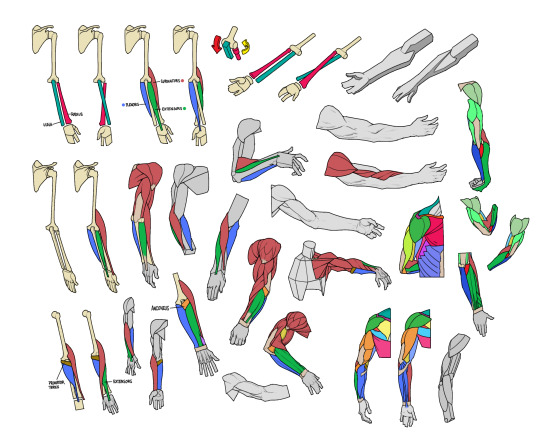


Clothing: I don't know any books that can really help on this front I apologize if I find any I'll update this post but pretty much all of my knowledge on drawing clothes boils down to the following rules: Where are the tension points, how stiff or soft is the textile, how is the form underneath the section of clothing behaving, and don't make even spaces between fold groups
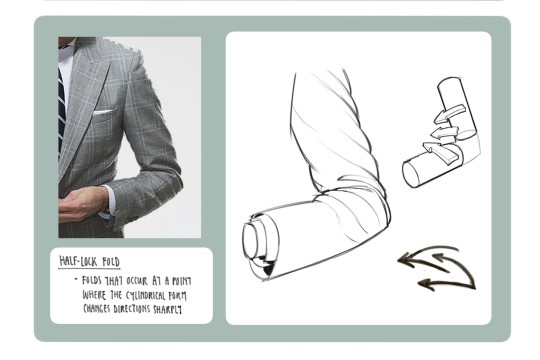
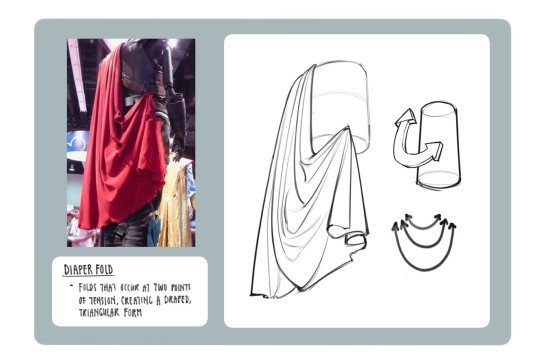
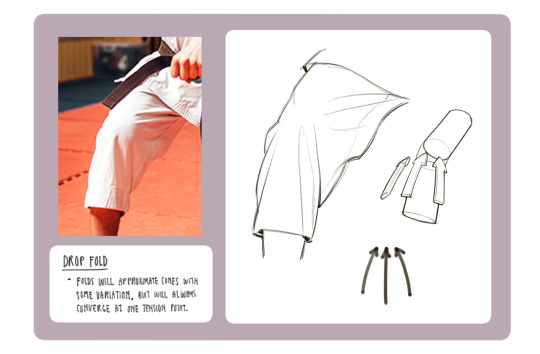
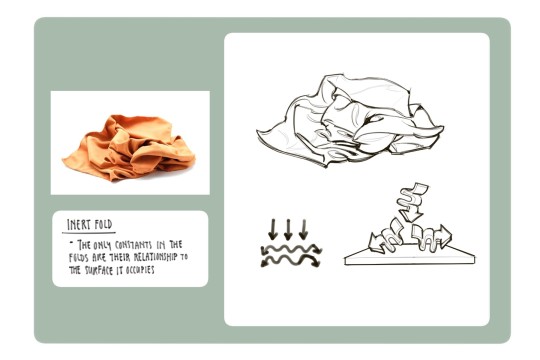
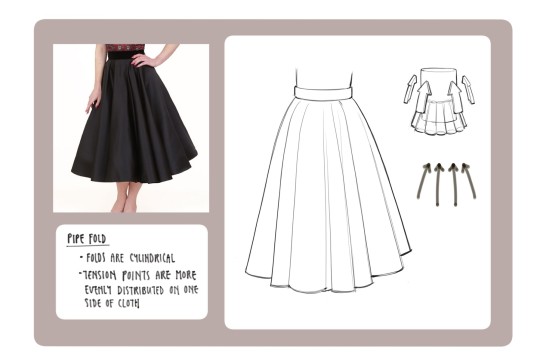
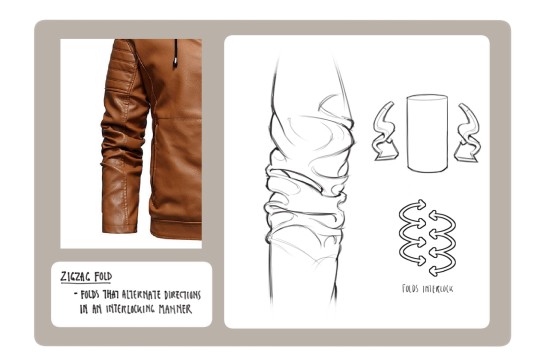
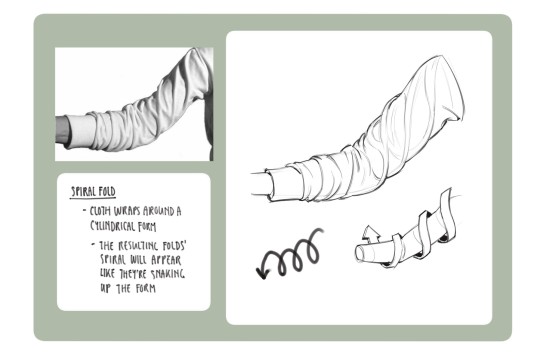
All of this is kind of moot though if it isn't applied through study or observational drawing though
Design:
I have to be really careful here because I don't want to deal in absolutes, the only absolute I'm confident espousing is that anyone who tells you there is only a small selection of methods you should follow to execute a specific type of design are objectively incorrect and just haven't figured out alternative if not more effective design solutions to a common problem. The only real Worst Thing I think you could do as a designer is create a pinterest mannequin devoid of a story, disconnected from its context in the world, and lacking in a clear purpose/personality but this too could be easily be disputed if maximising a character’s aesthetic appeal serves a purpose in its context, and my opposition to this design approach is my personal bias as a character designer for entertainment where emphasizing a character’s function and their relationship to said function is usually the goal
I think the 5 best pieces of advice I've ever received when it comes to designing characters are the following:
Try and follow the rule of thirds/general gestalt design principles of contrast
Always consider what it is you're trying to communicate with the character
Create believable transitions and reinforcements between points of interest
(Entertainment related) KISS principle/Keep It Simple, Stupid is your friend, the way a character wears or wields what they wear or wield will communicate their role in the world (who are they?), their relationship to their role (do they like their job? are they good at it? are they a part of an organization with the means to provide them things to perform their role more effectively?) effectively enough. Excessive information that bloats and conflicts with the communication objective weakens design (example: My favourite childhood toy for years was a pokemon plushie. Would I as a stay at home digital artist be wearing it as a keychain on my crusty paint stained polyester pajama pants when I'm at my desk working my job? is wearing it relevant to my character as a person who both no longer is invested in pokemon and is in this context focused entirely on comfort and doing my job? (no)). I think Elden Ring is an excellent example of a game that has visually complex designs but pretty expedient storytelling with its characters for worldbuilding
Study things that aren't just character design, to borrow from Lynn Yaeger borrowing from Sally Singer "If you're interested in fashion learn everything except fashion... Politics, art, painting- anything except fashion". Because people in different disciplines who work with different mediums or fields of study approach problems in different angles you may not have considered which can help give new ideas + often times the stuff you like was inspired by stuff that isn't at all what you would expect or enjoy yourself (To pull from a very popular example, Arcane is a League of Legends joint which was highly influenced by Warcraft which was highly influenced by Warhammer which was basically a giant response to western pop culture of the 1960s and the history of European warfare something something coconut tree).
Character design is kind of a hard thing to Get Good at considering how much of the actual process is super psychological/not bound by a *ton* of absolutes and has to account for medium and function (you kind of just have to have The Sauce) so I don't recommend Just studying independently only (possible, just very difficult). If you can and are interested in learning more about the specifics take some classes taught by people whose styles you fw who both know what they're doing and are good at explaining their process. For design for entertainment you can always check out Concept Design Academy or The Workshop Academy and see who's teaching there
As far as artist inspirations are concerned I think looking up the artists who worked on projects you like are a good starting point to figure out how you want to stylize. Going off of that at least currently my favourite designers/illustrators for entertainment with The Sauce are probably Evening Monteiro, Sergey Kolesov, Mindy Lee, Tonci Zonjic, Sasha Tudvaseva, Claire Hummel, and Yoshitaka Amano
My favourite book currently for tackling character design at least from a narrative consideration is probably Talking Threads: Costume Design for Entertainment Art (one of the authors is my friend and an excellent teacher!) and a lot of the stuff they espouse really helps to take into consideration individual and external factors when designing a character/how they can be used as vehicles for both individual storytelling and worldbuilding, gigantic reference point for my most recent casual project
Besides that the only other way I can really recommend studying character design is to just look at art, history, architecture, nature (pretty much Everything) and think about how ideas and concepts from those things can be applied to or communicated through a design or figure out what it was about a design or designs you like made it appealing
uhh tldr this is just how i as one among millions of artists got to where i am today as of January 16th 2025 my word is not gospel the advice I espoused here may very well spell my downfall tomorrow
166 notes
·
View notes
Text


Alright it's time for the SCP crossover stuck in my head ever since I finished this show.
Anderson Robotics holds the monopoly on robots in this one. And the foundation were the ones in charge of experiments to make the patch, with facilities on every exoplanet humanity settled. They even made special security drones just for the foundation to use.
Also when solver infected drones first appeared, the foundation assumed it was a slip-up between the anomalous and non-anomalous robots, since the company has its beginnings with magical robots. After the company cleared it up with foundation, they began a somewhat low-priority investigation.
At first the hypothesis was that the solver's anomalous properties were Mechanite in origin, and after they discovered its biomechanical nature, maybe it was Sarkic in origin. It was also suggested that this anomaly was a rare combination of magic from both rival religions. Others suggested it was [REDACTED].
Then the solver got to its second and third phases and it all went rapidly downhill.
Further info below in the fashion of SCP documents+art.

Status Update: Personnel Demographics
D-Class: 73% drone 25.5%human 1% Thaumiel Class SCP 0.5% Anomalous drone
Security: 50% drone 40% human 6.5%Thaumiel Class SCP 3.5%Anomalous drone
Tactical Response: 34% drone 65% human 4.8%Thaumiel Class SCP 0.2%Anomalous drone
Field Agent: 88% human 9% Thaumiel Class SCP 1% anomalous drone
Mobile Task Force: 90% human 9.5% Thaumiel class SCP 0.5% anomalous drone
Notes: The agreement between the Foundation and Anderson Robotics has eliminated any chances of another D-class shortage. Despite the approval from the ethics committee, there are growing concerns about the possibility of drones “waking up” and achieving sentience. This has been a concern since Anderson Robotics released their first non-anomalous worker robot to the public, but sentient or not, the foundation requires sacrifice to learn more about SCPs, especially world ending varieties.

Test subject requests, 002:
Stereo system [APPROVED][DENIED] Kitty eared headphones [APPROVED] Digital copies of albums from the bands: "Babymetal" "Linkin Park" "Sabaton" "Korn" "Ghost" [APPROVED] Digital copy of a library of video manuals on various martial arts styles [DENIED] Art supplies [APPROVED] A "Sword and rematch with SCP-076-2 while kickass metal music plays in the background" [DENIED] Visitation for SCP 079 [SUPER DENIED]
048:
Digital library of arcade games from the 1970s-1980s [APPROVED] Digital archive of Russian and Soviet tanks + blueprints [DENIED] translation: "Make [test subject 002] keep it the fuck down over there" [SURE]

Note: MK Excorcist test subject 002: Test subject’s requests for visitation with keter class SCPs has increased in frequency. Subject has grown more hostile, attempting more containment breaches, and violent altercations with security personnel. Test subject continues to regain knowledge of these SCPs despite deletion of memory files. It is recommended to keep it occupied with media such as anime and video games. Suggestion to only allow anime that requires hundreds of episodes to finish, such as “One Piece” and “Jo-Jo’s Bizarre Adventure” Pending.

Addendum 468395-17:
If you are reading this, you are either an 05 council member, A high-clearance survivor, and reading this from the moon, or one of few clones for the personnel shortage after the core collapse. A few years after this event, we lost contact with exoplanets one after another. We did the math and the time lines up with how long it takes for a ship to get to those planets. There’s not really anything we can do about that while there’s a fucking hole in the earth, but you’re probably aware we’ve prepared for worse. For now humanity will lay low and look for an opportunity to terminate the Solver with sunlight or other means. Of course, the damn thing is aware of this and has thick clouds block the sun as part of its third phase. Not to mention it can just absorb that light by spawning black holes. We’ll be laying low for a while.
Addendum 468395-18:
On [ ]/[ ]/[ ], the singularity ceased all activity for twenty seconds. Investigators noted the illumination on the tendrils “flicked off”. After twenty seconds the singularity returned to its normal behavior for 9 minutes and 23 seconds, after which the singularity proceeded to [REDACTED] before permanently ceasing activity. The foundation was able to begin the planet’s recovery process in a few months. SCP 2000 got to work with the cloning process, but with the state of the planet there’s no chance to restore earth to its original condition pre-core collapse. Right now all we care about is coming back from the brink.
After activation of SCP 2000, attempts at contact with the exoplanets will commence. As a host for the transfer of several Keter-class SCPs, and the last known location of the latest host of SCP 468395, contact with Copper 9 is a priority.
#Murder drones#SCP foundation#Uzi Doorman#serial designation N#Nori Doorman#Khan Doorman#MD SCP AU#SCP 173#SCP 106#Anderson Robotics#Murder drones AU#cheezy art#Nori is holding SCP 316 in the last pic
24 notes
·
View notes
Note
As someone who loves to work on lineart but struggles with details, it was really inspiring seeing the progress of the hawke/sebastian drawing!! Thanks for sharing~ I would love to see more in the future if you’re up for it ^^
.Tysm!!!! I do love making timelapses and rewatching them myself to figure out if I’m going wrong somewhere, it’s like resetting your eyes mid picture. I do also love seeing other people’s processes too. I realised the other day why I like digital art and drawing in ink traditionally, it’s because I get to keep the actual process of the image, in 99% of my sketches traditionally I’ve drawn messily in pink, and drawn cleanly over it in black, and with digital art it’s just there on another layer. I am such a huge fan of process that it outweighs that final piece of art for me.
.I also think there’s a lot that can be learned from an artist’s process over idk a tutorial they make; I remember a while ago I asked another artist (I cannot remember who girlie mb ✋😬🤚) about drawing hands, and they made this nice little post that did help me but probably not how it would be expected, because with that post I realised my issue was with the foundation shapes I was drawing weren’t blocky enough for what I wanted. A simple “this is my process” from someone else helped me figure that out.
.For detailing! I find that not actually initially sketching everything helps a lot, (in my Sebhawke I actually add in Sebastian as an afterthought lmao it was just going to be Hawke on his own 😂) both in the fact that if you think of something mid picture you can just fit it in with little problem, and sketching loosely helps to free up and relax the hand if you’re getting a bit stiff drawing solely lineart. Also, I don’t know if this applies to anyone else but sometimes I’ll get a bit stuck on drawing a certain part of the image (maybe it’s a hand or idk how the clothes are supposed to lay) and it’s a really simply solution to just sketch it over the basic sketch, so it’s a bit more detailed and easier to lineart. Like idk what part of my brain was like “once the sketch is finished you can NEVER go back to it” because that’s stupid as hell; I’ll be on shading and realise that I could wedge something in somewhere and just go straight back to sketching.
.I do think that heavy detail is something that has to be built up to though, it’s not like something that can be done instantly without probably burning out or ending up hating detailing work. It’s also mental to look back on my stuff from like 2020 that I thought was so detailed for my skill at the time, and then comparing it to what I was making in 2023 which has as much detail in as I could manage; like that is progress and there’s no way I could have made that level of detail before I’d built myself up to it. And that compared to what I’m making now 😭 ……bro… I think my main issue is that I don’t know exactly how to flesh out medieval / fantasy stuff in a way that looks proper, just from like actual lack of knowledge about the time period even though I’m 👀🥴😩👌 about it, whereas cyberpunk was considerably easier because just slap a bunch of fans and wires and boxes and you’re good to go 👌.
.As an added note, detailing can literally just be drawing like a 3d shoelace instead of just a single line to represent a shoelace. Then you start drawing the eyelets in another picture, and then you do the proper stitching on the shoes, or maybe a distinctive tread, then maybe there’s buckles or velcro or a designer label on them. It’s not something to hyper fixate on all in one go. Literally just drawing the seams on clothing adds a layer of detail, (and also shows form!) and now I’m like rarely ever not drawing them because it’s just subconscious for me to add them in.
.Realistically I’d like to make proper timelapses that are actual screen recordings as opposed to what CSP shows because there’s probably a bunch of times where I’m just sitting there thinking about stuff or getting distracted by research, and that doesn’t show in my current timelapses; I don’t just one bomb these pictures!!! I faff for a fair bit of it!!! Also rotation and zoom on the canvas, the CSP recordings are kind of deceptive in omitting those.
.Anyway I have a timelapse tag for all my timelapse stuff, which is…. not a lot but STILL!! Also there’s this timelapse of my zevwarden picture from a bit ago that I never uploaded whoopsie 😘💕.
#owlito#answer#timelapse#video#.detail is wonderful but you must understand I am a cluttered maximalist.#.i am a hater of negative space.#.why empty!!! why not full!!!! put something there!!!!!! AHHHHH!!!!!!!!.
15 notes
·
View notes
Note
About the court case:
you are aware that all of the screenshots from discord and other social media sites that are commonly used as evidence against Viv wouldn't be accepted as evidence in a court of law, right?
Screenshots are only admissible evidence in court if they pass authentication requirements; which means you have to have records of when, how, by whom, and on what type of device and operating system it was captured. You also have to prove it wasn't altered in any way and include the metadata of the screenshot. Primarily because it's very easy to alter or falsify digital screenshots.
If you're unable to provide any of that, the court will just throw it out. In fact in most cases screenshots are thrown out by default when presented as evidence. There's tons of legal precedence for it:
Moroccanoli v. Marc Anthony Cosmetics: facebook screenshots were thrown out because they couldn't be authenticated.
United States v. Vayner: A print out of a website was rejected as evidence and that decision was upheld by an appeals court TWICE.
Edwards v. Junior State of America Foundation: the court rejected an attempt by a plantiff to provide screenshots of deleted facebook evidence instead of native files, citing best evidence rule.
Unless you can prove without a shadow of a doubt that all the screenshots of Viv's wrongdoings are 100% authentic with proper metadata to back it up, no court will accept it.
Kendraws has proven that their messages are real and not faked. If you noticed from the last ask I said I would prefer an *ex-employee that has been through the firsthand experience with viv. Also also, spindlehorse is handled through discord and that is where her 'official' business goes through which is shady and weird! Even if messages can be edited/deleted if someone archives the original server the way it is to reveal what goes on behind the scenes then that would be substantial proof bringing an entire laptop/printed receipts over 'yes your honor these are her messages, timestamps, double verified over the original server the way it is and messages before editing'. Im not discussing just screenshots here, obviously, but there can be email confirmations and overall messages from discord because it's been proven that that's what sp1ndlehorse uses.
I think this is a unique case study over the fact that, again, sp1ndlehorse uses and is primarily on discord to pay and communicate with their artists it is not an official licensed business. I'm aware that sometimes internet drama isn't taken seriously but If some ex-artists rally up enough people to actually speak out about this sort of mistreatment and mispay there CAN potentially be a genuine case about this sort of issue at hand. If multiple artists have to come out to say 'she doesn't pay her artists can anyone do something about this? I was paid 20 per shot, someone else was paid 30, and another one of us was only paid 15 per background art'. I think the time is ripe enough to try and make a case here even if multiple artists have quit and only worked on one episode, due to the toxic nature behind the scenes which is kept on the downlow something needs to happen! Not to mention, thinking about it shes been scamming/not fulfilling her patreon for a while to my knowledge her patreon could also be taken down or someone could get her over that as well considering shes funded fully through youtube, Prime, and A24 soooo dont see a reason for her to still keep up an over 5 year old patreon that.... I'll take a court case about tax fraud at this point, mismanagement, or improper crediting ANYTHING.
https://passionfru.it/hazbin-hotel-spindlehorse-studio-46812/
There have been artists that have stated about mispay and mistreatment multiple times. Huge red flags and very weird behavior all around about pay despite trying to cover it up as 'freelance pay fluctuates' there's obviously favoritism within the 'studio' about this sort of thing.
Believe what you want to believe but face the facts knowing artists are mistreated, miscredited, and outright silenced because nobody wants to believe the actual people that work on this and animate it but would rather take Adam Neylan/V1vs word over them because 'Oh they can't be that bad'.
I'm tired of the excuses, and again, I'm not pursuing a legal case I just want justice for the artists and for sp1ndlehorse to maybe learn their place or outright get sued from mismanagement :/
#yeah there is metadata about this sort of thing wonder why nobody takes it seriously =_=#if artists start archiving about this situation then the build up over this case can be believable and happen in due time.#anti spindlehorse#anti vivziepop#helluva boss critical#helluva boss criticism#helluva critical#helluva criticism#helluva critique#anti helluva boss#anti hazbin hotel#anti brandon rogers#anti adam neylan#vivziepop critical#vivziepop critique#vivziepop criticism
13 notes
·
View notes
Note
This probably feels weird to ask
But I love how you draw dipper in general and your art in particular! Is it possible you could do a little tutorial on how your process goes?
If you don’t want to, I understand completely. I felt really hesitant asking this lol. Anyways, love your art!!!
I'm not the *best* at talking technicality, and certainly not about drawing Dipper; I have three distinct styles when dealing with him, that being Billdip Dipper, Canon Dipper, and AU Dipper, all of whom have entirely different purposes both visually and narratively. This results in some pretty inconsistent representations:
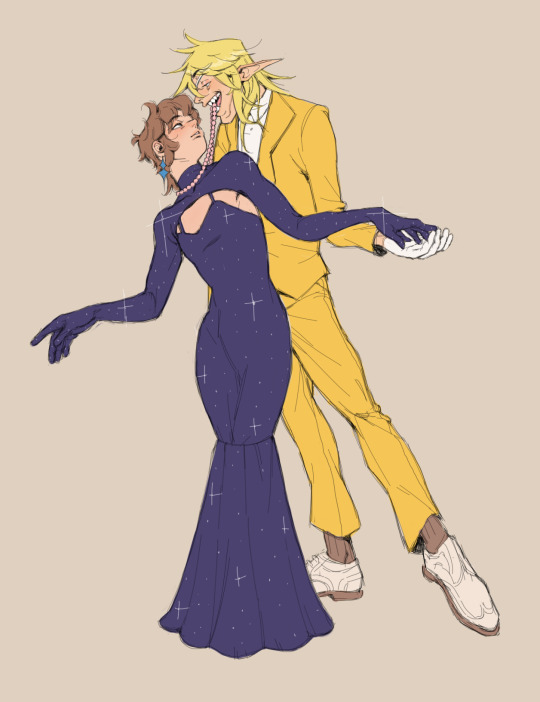
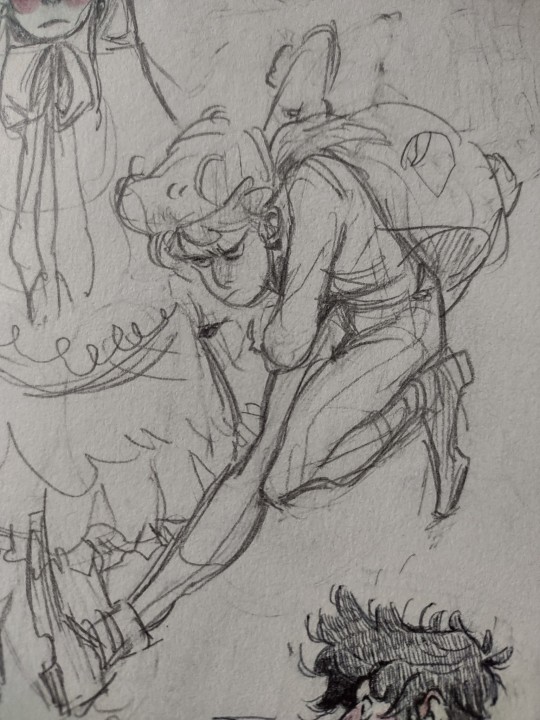

That being said! I'm totally cool with going over my process with you! Layout, technique, brainstorming, all that.
Generally speaking, I like to start my digital work on paper. Nothing crazy, just a basic idea that captures the pose, expression, and clothing (these things are destined to change by the end).
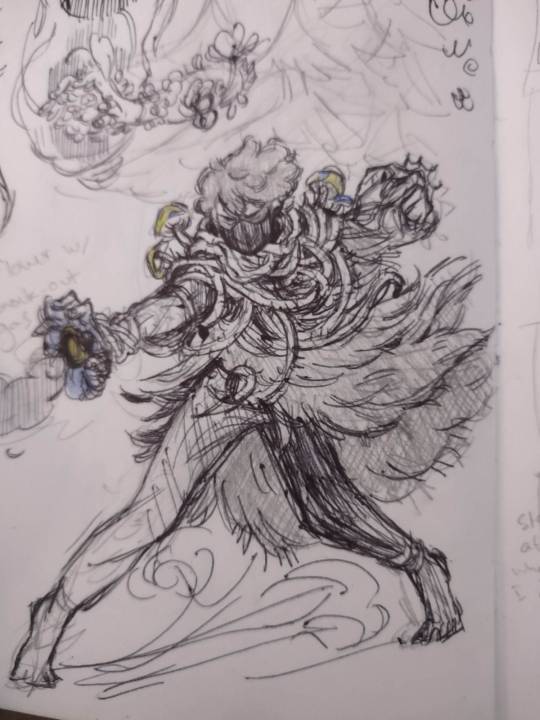
Notice the cloud of dirt kicking up at his feet. Look how I position one arm out while the other pulls farther back, and his hair blows from his face. There's a clear emphasis on motion here, both in body language (feet turned against the force) and added attire (Pinetree cloak flowing back, dust cloud at his feet, etc.)
This design is destined to change, but for action scenes like this, it's good to begin with an expressive foundation, so that once we start chipping away at and remolding our concept, we're building off of a design that encapsulates the *scene* we're wanting to convey. That is, no matter how much we shave off, we still have a strong foundation to reference towards and lean into for inspiration.
The next step is transferring our rough sketch into a digital setting.
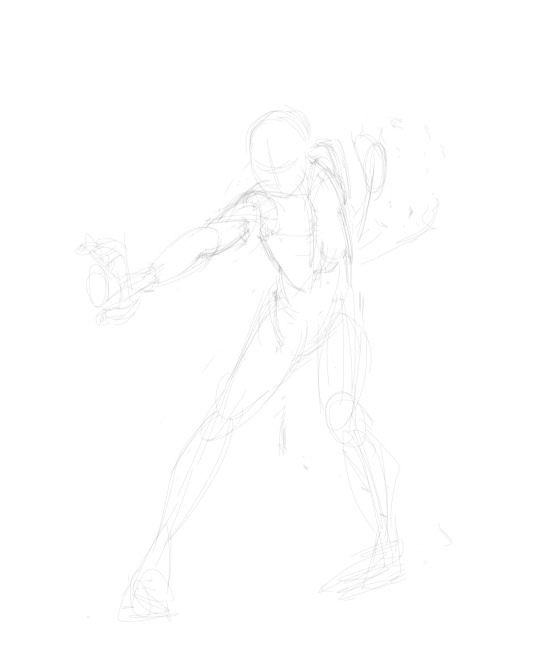
This is where I tinker with the lasso tool, maybe take reference photos of the exact pose I had in mind. Here, I'm just breaking down my original sketch on a tablet. I readjusted the feet's position, pulled that other arm in to his chest, and straightened his arm out for a more powerful pose.
The next step focuses on pushing the pose and correcting anatomy errors.
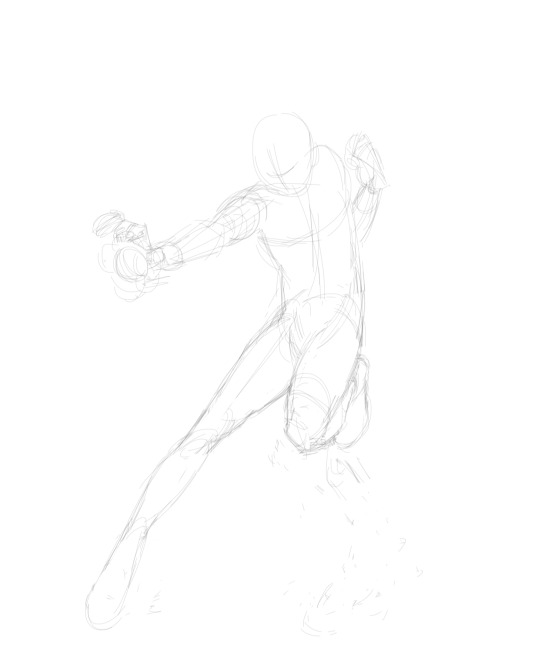
Alright, cool! Now he's not just bracing for action, he's *jumping* into it. The back arm's pulled in like a fist, his shoulder bunched up close to his ear. We see how his body's twisted at the torso, chest out, legs stretched, arm extended.
Notice too how I utilize my shapes to empower the pose. Front arm and leg, extended. Lots of straight lines. It *curves* because of muscle and fat, but outside of that, they're pointed in a distinct direction. Contrastly, his right side curves at the hip and follows subtly up to his chest. This helps emphasize his lean into whatever he's attacking, sort of like a bow.

Now we've added details! You'll notice I've changed a lot of my initial design from my rough-sketch to fit more into the style and personality of Dipper in this setting. Since he's, you know, a "Pinetree," I figured his clothing should reflect it. I'm still working in pencil at this point, blocking out the general shapes of what I want, but not really exploring my options.
The cloak follows a slight gust, his hair flows back, the mushrooms on his shoulder lean out from the action, but these are still only guidelines. Keep it loose! Explore things! Have fun with it!
Next step, Inking. Digital art is *very* forgiving, so I'm a lot less concerned about moving forward without a full idea of my vision. This is usually the step I'm most inspired at because it allows me to go back over my loose sketch and add those minute details that excited me so much. I do not recommend moving forward without full confidence in your initial sketch when using traditional art! YOU WILL CRY!
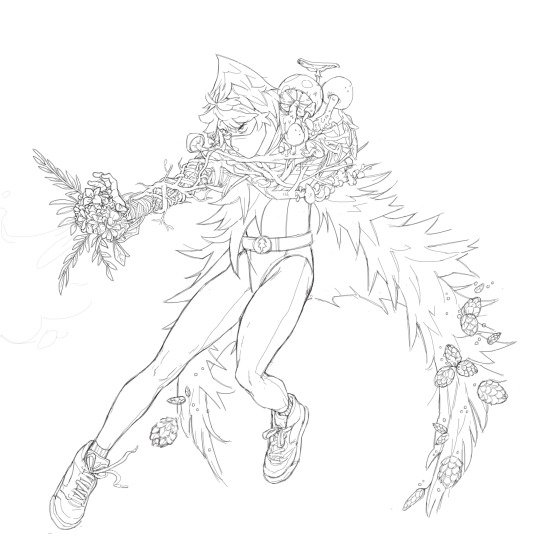
Clothes: changed. Pose: changed. Details: expanded on.
This is where a bit of knowledge in anatomy is really going to serve you well. Bridging the gap between sketch and ink has always been very difficult for me, and it's due in part to those uncertain, not-quite-right bits I have to build off of from my initial sketch.
It's good to keep your rough draft light and fluid so that they capture the emotion and general pose of your character, but it's also important to keep in mind how you'll have to balance *maintaining* that level of expression while incorporating more realistic aspects of their design.
Take for instance Dipper's left foot that went from being tucked up under his butt, to being in a more braced position- like he's about to land, or skirt to a halt. As a loose sketch, it captures the motion very well. However, incorporating muscle and kneecaps and detailed shoes brings out a lot of the visual flaws. Proportion and angle become a serious issue if you aren't entirely sure how a particular body part would flex/squish/shorten in a particular position. The more realistic you go, the more jarring your mistakes.
This is, of course, not me saying you're forbidden from drawing your characters with a leg under their butt with big, meaty thighs. It's *actually* me letting everyone know that I tried working with the pose, building on it looked weird, and I decided to take a different approach. You are 100% allowed to try something else if your initial plan doesn't work out.
This step is where we adapt and improve. Our digital rough sketch didn't really capture the full power of his motion. His cloak kinda billows out like "Yeah, I'm a cloak, I billow gayly." It's flat, hollow, uninspired. Here, you're looking at photo references of Pinetrees, both real and not-real. You're gonna have to make it look like needles and branches, while *also* being a flowy bit of clothing.
For this, keep in mind how *cloth* moves with a more exaggerated, majestic rough sketch to overlay atop our failure of a branch jacket. Die.
See how despite the spikey pine needles, his cloak follows a distinct pattern? Additionally, this coat works in 3-dimensions. There's an outside and an inside, and it curves like a dome around him. It floats behind him, curves in front of him, lifts up, dips down. Really, it's up to you, but always consider your work on the third plain.
ALSO! Very important: Keep an eye on your line weight! Seriously, this took a long time for me to get a firm grasp of. Not *shading* really, but put a bit more emphasis on those bent spaces with darker lines. See that bold line connecting his thigh to his glutes? And the one behind his knee? DEPTH!! IT ADDS DEPTH!!
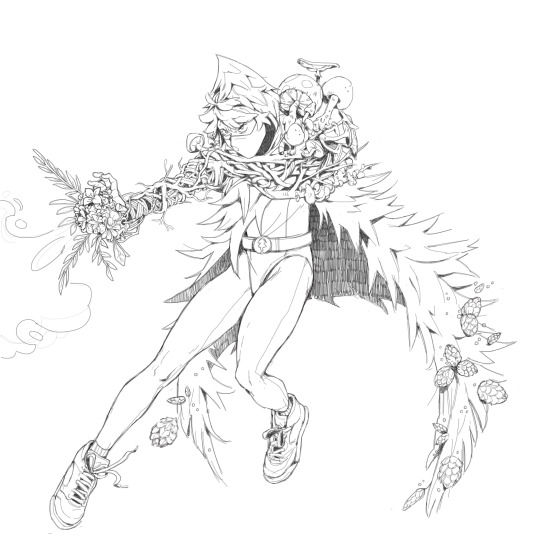
And *here* is the final product! This is the shading section, arguably my favorite and least-favorite part about my drawing process. Working in black and white, you don't really have to worry about getting every little shadow on your character. Just shade what needs emphasizing; everything with a shadow gets an added layer of depth as well. This is the part that gives your work an additional POP.
Consider too that shading isn't just solid black, even if you're working in black and white. His arm and under his hood are pretty solid black, but the interior of his cloak is far more textured and light. We see where it's darkest at his sides, but leading out, it lightens into distinct markings that (in my opinion) are visually more appealing. Using this tool is ultimately up to you, though.
Okay, the end!
112 notes
·
View notes
Text
9th feb '24 - [arch] characters, interactions and emotion - making a mini webcomic
Gahhhh Shri this has been an absolutely crazy couple of weeks!!!! Hope you are doing well :)) First of all, WOW! You have a lot of goals, and I’m sure you’ll get them done! I’ve worked a lot on my graphic design during the process of making Winter Wellbeing. If you wanna see a blog post dedicated just to that, I can do so! It would be cool to compare notes on the approaches we take for graphic layouts. If you wanna share your knowledge of camera skills when you build that up that would be awesome 😭😭
It’s been a tough few weeks, art wise. I have been reflecting on my process, motivations to create, the ego and all the baggage that’s lumped into the creative process for me. It turns out there’s a lot. I took some space from my illustration practise (literally for a weekend!) and began to realise how dysfunctional it is. I’ve been writing a lot about that so there may be a larger piece of writing coming about that at some point (no promises!!)
But for now, let's talk about little successes!
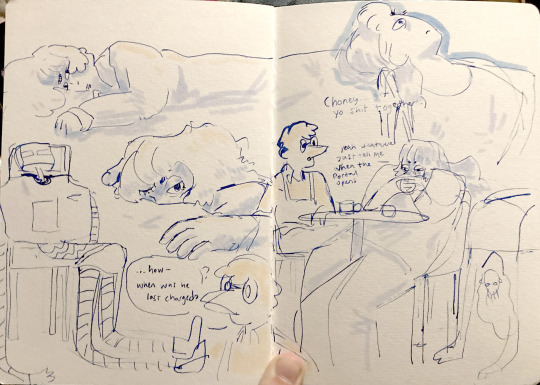
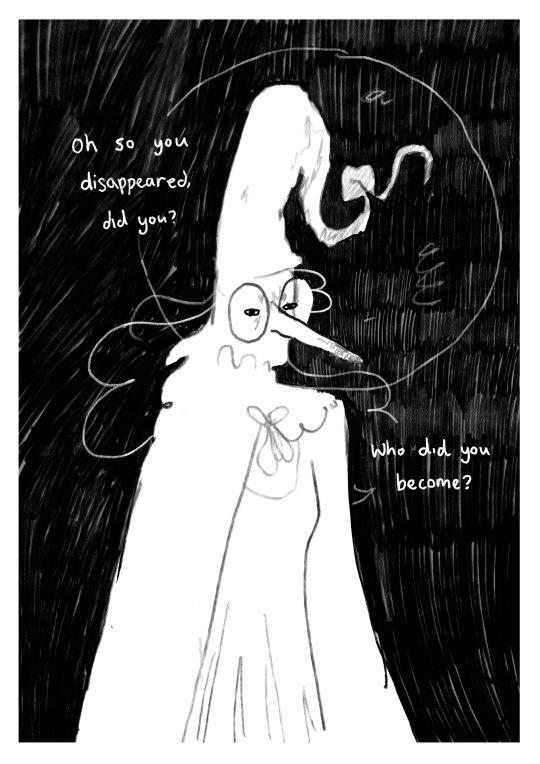
I’ve been playing with some characters for a while but I’d hit a bit of a block with the plot. I realised the expectation of having a finished project of high quality soon is unrealistic, and an unhealthy expectation to put on myself. I rarely give myself time to play with concepts for a long time and let the characters, plot and interactions evolve naturally. Maybe this in part came from sticking to the short university module turnaround. I noticed that that short turnaround was causing a lot of block, so I have decided to bench it as a comic for now and focus on using it as a playground - falling in love with the characters, creating stories and drawing them for fun. Maybe years down the line I’ll make them into a comic - we shall see!
I *tried* to do hourly comics day this year and it didn’t quite work for me. I think I made 3 comics? And then got distracted with a bigger project that ended up taking a week or so to complete. Let’s have a look at it, shall we?
[you can find the full version here]
First of all, it’s based on an unfinished fanfiction I started a couple of months ago, which was mostly bad, but there was one nice scene that I liked and wanted to expand on. I started by having a look at the script I wrote and thumbnailing on the iPad. I’m away from home at the mo and usually would prefer to do most of my artwork traditionally, but because I don’t have access to a scanner, the whole process was digital this time. A lot of the pages got scrapped because the dialogue wasn’t necessary, and I’m not drawing pages that aren’t necessary.

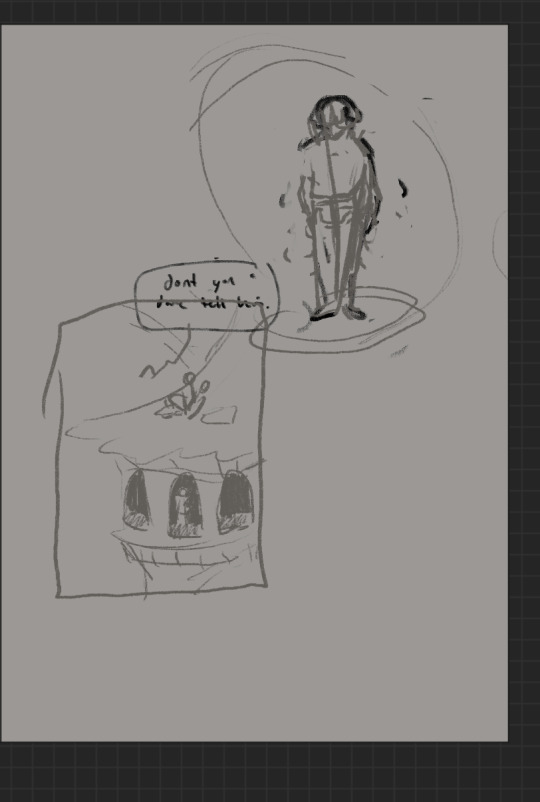
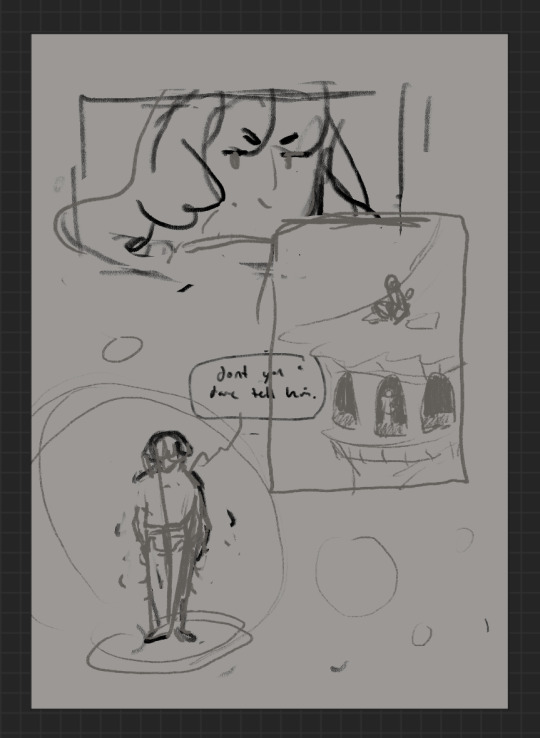
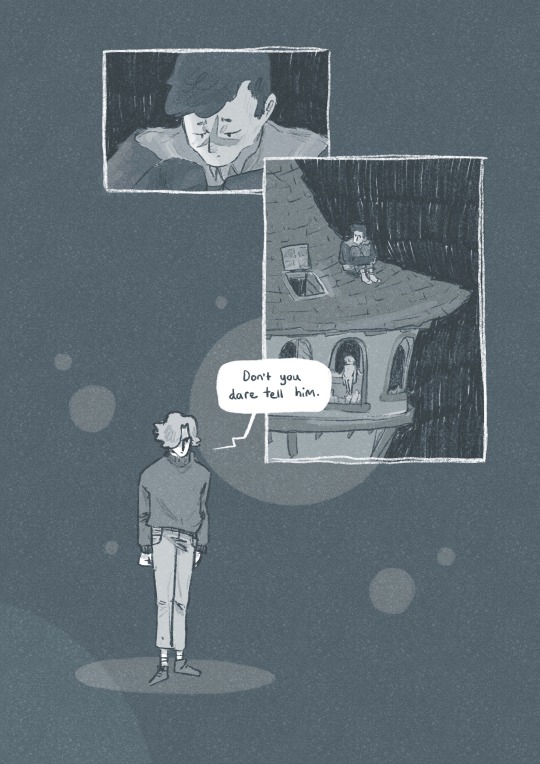
some more development screenshots
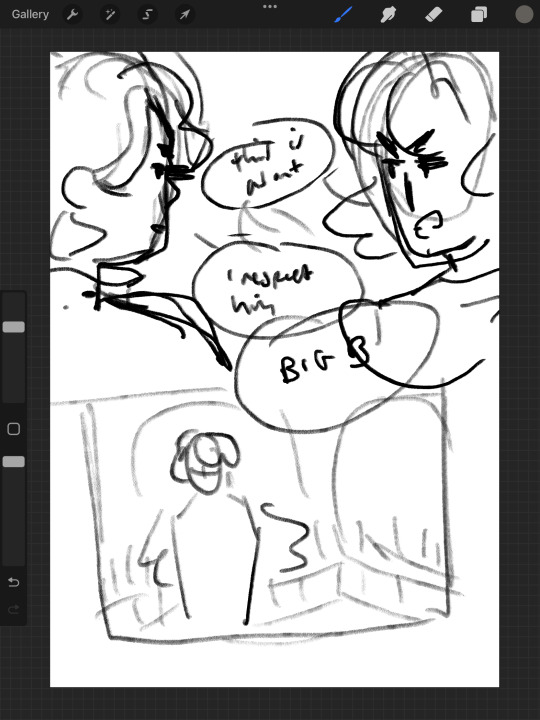

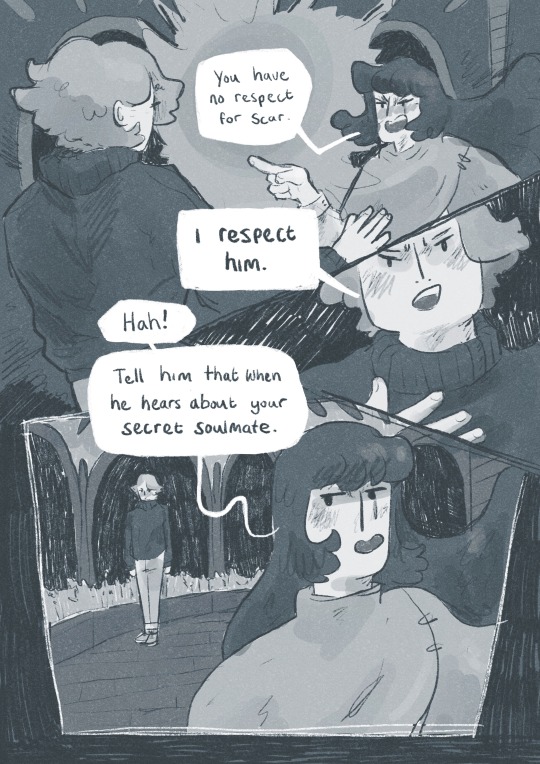
I thought a lot about posing during the process, acting the scenes out in my mind and sometimes physically, really understanding the emotions of the characters, why they’re saying what they’re saying, their tone and how to convey that though their body language and expression (i find grian really annoying normally [affectionate] but I want this grian to step on me).

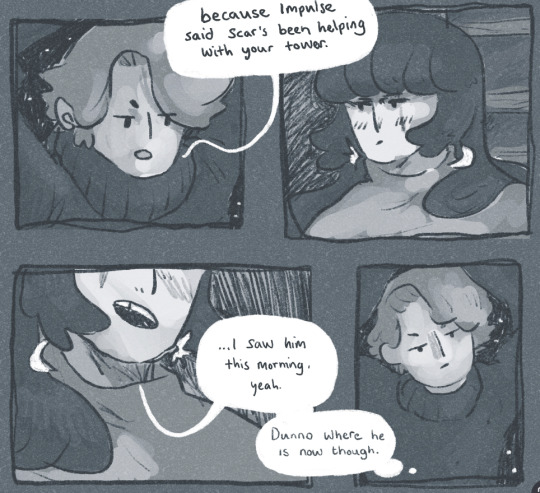
Pearl was hard with this because she’s quite erratic and unpredictable in this series, so I wanted her to switch from raw explodey anger to playful jabs at Grian. I’m hoping this comes across as somewhat insane, rather than tonally off and inconsistent. I did super enjoy drawing her and her explosive nature though, especially in comparison to Grian’s coldness.



I played with levels and monotone colour too - I’m not working with multiple colours much at the moment so I’m able to focus on things like values composition, characters and backgrounds. My skills limit the kind of stories I can tell currently, so I’m working to improve those foundations. Maybe when I’m back in the riso studio I can play with colours a little more.
Colours - despite the simple pallete it gets a bit nerdy here.I stuck to specific flat percentages for most of it - Pearl’s hair and Grians jumper are 60%, Grian’s hair and Pearl’s cloak are 20%. Then I added a 14% layer for shadows, using a ahrd blend eraser tool for highlights, making the images quite dark. I fill a layer with texture from Forystr’s riso brush for procreate, and turn it into a 40% opacity colour dodge layer. This gives it some much needed texture and makes the lighting feel low and nighttimecore. It also pushes the values to look really nice - I tend to be too scared to push them by myself.
I tried a few different colour layers to get a *vibe* but settled on a low percentage riso blue in a colour layer. All layers besides the riso blue are in a riso black, colour picked from a riso colour pallete. I learnt these tools - using percentages to get good values - from working with risograph. I really recommend having a look at these techniques and doing some monotone work. It's really improved by character designs, page layouts and compositions.



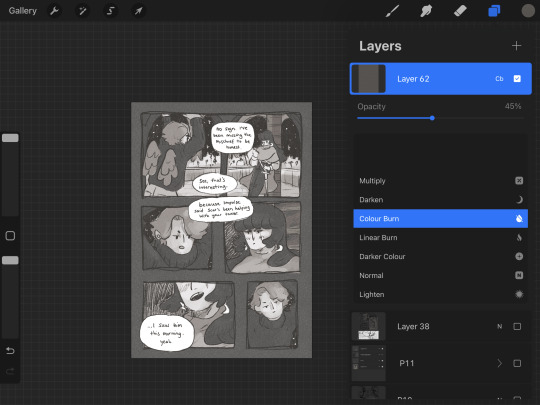

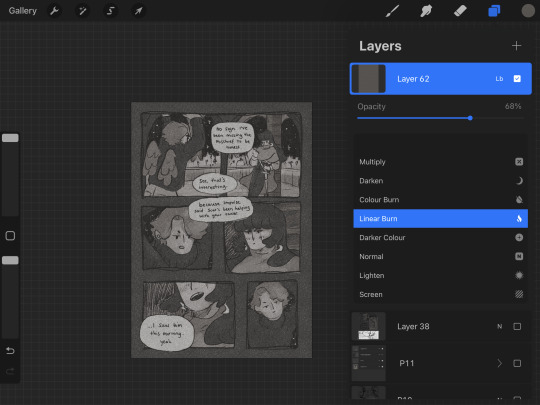

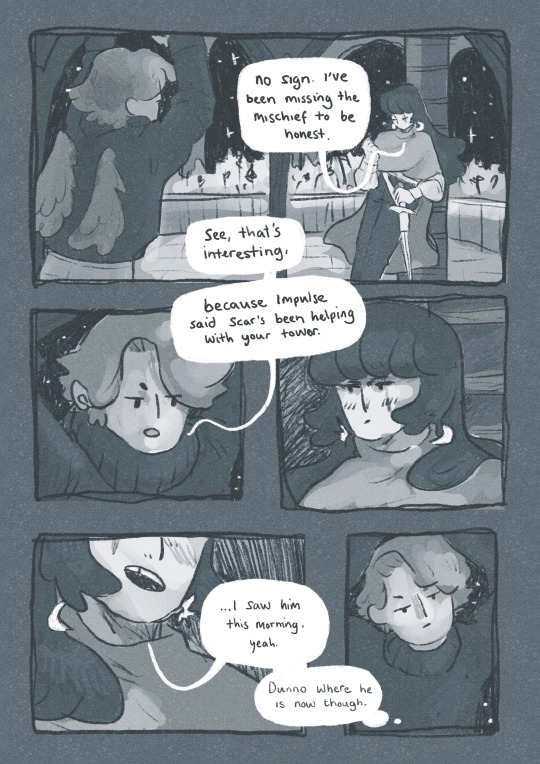
That's all from me today, though I have had MANY other thoughts over the past two weeks about creating, but perhaps we'll dive into them another time. If you (or anyone else) has any questions, hit me up with a reblog or an ask and I will get right to it. Lovely to hear from you! Hope your art is going great too :)) Arch :)
#archillustrates#arch is learning#project development#art#art process#art resource#process#artists on tumblr#illustration#comic#picture book#small art blog#art blog#illustration blog#female artists on tumblr#queer artists on tumblr#illustrator#book illustrator#female illustrator#queer illustrator#comic artist#comic art#female artists on instagram#artists on instagram#procreate#digital artwork#digital artist#artist blog#artist on tumblr#web comics
29 notes
·
View notes
Text
Level Up Your Online Business with Internet Millionaire Digital

I've been tinkering with various online ventures for a while, but never quite cracked the code to turn them into sustainable successes. That's when I stumbled upon the Internet Millionaire Digital membership area, and it's been a game-changer for my entrepreneurial journey.
A Treasure Trove of Resources
The membership area is like a treasure chest overflowing with valuable resources. It boasts a comprehensive library of video tutorials, in-depth articles, and insightful webinars, all meticulously crafted by industry experts and proven online entrepreneurs. No matter your experience level, there's something for everyone. For beginners like myself, the foundational modules provide a strong base in various online business models, while more seasoned entrepreneurs can delve deeper into advanced strategies and growth hacking techniques.
Expert Guidance at Your Fingertips
One of the things that truly sets Internet Millionaire Digital apart is the unparalleled access to expert guidance. The platform features exclusive interviews and live Q&A sessions with successful online business owners. These sessions are a goldmine of practical advice and real-world insights. Being able to learn directly from those who have built thriving online empires has been incredibly inspiring and motivating. It's like having a team of mentors constantly by your side, ready to answer your questions and offer personalized guidance.
Supportive Community Fosters Growth
The sense of community within the membership area is another aspect that I've found incredibly valuable. Connecting with other aspiring and established online entrepreneurs provides a fantastic support network. The member forum allows you to share your wins, challenges, and ideas in a safe and encouraging space. You can learn from others' experiences, collaborate on projects, and build meaningful connections that can propel your online ventures forward. The positive and collaborative atmosphere within the community fosters a sense of shared purpose and keeps you motivated on your entrepreneurial path.
Actionable Steps for Real Results

The Internet Millionaire Digital membership area isn't just about theory; it's about taking action and achieving tangible results. The resources are all designed to be actionable and provide clear, step-by-step guidance. Whether you're building your first website, launching an e-commerce store, or mastering the art of affiliate marketing, the membership area equips you with the tools and strategies you need to succeed. I've already seen a significant improvement in the performance of my online ventures thanks to the practical knowledge and actionable strategies I've gleaned from the membership area.
Overall, the Internet Millionaire Digital membership area has been an invaluable asset in my journey towards online business success. It's a comprehensive and constantly evolving platform that provides everything you
#internet marketing#internet archive#internet finds#internet culture#internet censorship#the internet#Internet Millionaire
2 notes
·
View notes
Text
ADV4310: What I Know and what I question?

When thinking about digital media, the first thing that comes to mind is the ever-evolving landscape of social media and the constant emergence of new technologies. My basic knowledge of digital media revolves around the dynamic interplay between creativity and technology.
Foundational knowledge has solidified around the art of storytelling across diverse digital channels (social media platforms), the pivotal role of captivating visuals, and the strategic integration of data analytics. Yet, as I stand at the intersection of academia and industry, questions about the trajectory of digital media persist in my mind. I know of the significance of compelling storytelling across various online platforms, the power of visual elements in capturing audience attention, and the critical role of data analytics in shaping targeted and effective campaigns. All of the above is just a small fraction of what I think digital media is and what it looks like.
One aspect I find intriguing is the rapid evolution of technology and its impact on media consumption habits. Many of us have probably become aware of the recent rise of AR and VR and the exciting possibilities it presents. However, regardless of how catchy this all might sound, I wonder how these advancements may reshape user experience and influence content creation.
Something I have been eager to learn is media production skills and UX design. One reason for this is my passion to become a Product Designer or UX Designer. UX goes hand in hand with digital media since oftentimes you are designing digital experiences that are user-friendly and engaging. I want to explore concepts of usability, accessibility, and user interface design.
I would also want to learn more analytical skills since it seems to be getting more and more important within the marketing and advertising fields, especially in digital marketing. I'd like to learn more about blogs and how to write them, how to have better presentation skills, and just a better outlook on digital media in general.
2 notes
·
View notes
Note
Thanks beyond thanks for the reply - you'll definitely get credit (or at least a big tip if i can ever finish this project and get it out there), because you're among those I've learned from, and coming from a position of zero education and no modern programming knowledge, I can assure you: it's been difficult to piece together an education in game design with an improvised curriculum, so every little bit helps. While most people who get into this come from a programming background end up needing assistance with the art and music ends, I'm coming at it from the opposite side of the spectrum: I've been composing, recording, and engineering music since the magnetic tape era and doing digital design/animation for just as long, so it's just the coding I have to really apply myself to and make myself learn. I won't lie: it's been frustrating, trying to figure it all out by reading manuals and various youtube videos, reddit threads, and yoyo forums because while I'm able to learn the functionality of the code easily enough and there are a lot of helpful resources out there in that respect, context is everything and it can be maddening, trying to figure out how to apply what I've learned in useful or practical ways. For example, I've figured out enough to know that data structure grids can probably help me overcome my current problem with collisions (like you, I began building my 2.5d environment from that exact Matharoo video and even managed to write a pretty decent place-meeting-3d script from the ground up... until, like you, I hit my current impasse of being unable to figure out how to handle multiple collisions at once... but, unlike you, every alteration i make to my code only creates more problems), but while I understand how ds grids work, I can't figure out the proper context in which to apply them as a solution to my collision problem. So, I'm giving up and resorting to reverse engineering - when it comes to a lot of things, I can usually figure stuff out if i can just see it working under the hood, so i hope that's true for ds_grid collision implementation. I'm telling you this because I downloaded your suite of 3d scripts and intend to try and figure out how to implement them, working backward. I honestly don't mean to steal all your work, as you've been more than generous in helping people like me by sharing it in the first place, but it's hard to resist using it as a basis for my education because the physics of your project and your design process and ideas (like self-skinning objects) are so similar to mine. I can assure you, though: I won't be simply copying and pasting your functions, because I have no idea how to use them or from where to run them... it'll be trial and error (already, in trying to structure a Shaun Spaulding-style collision code (might as well start with what i know and see what works!) using your version of place_meeting_3d, I immediately encountered a "variable not defined" error in the instance-place-3d script it calls... maybe because I'm substituting noone for null, which is a variable gm doesn't appear to recognize, or maybe not... this is gonna be fun). At any rate... thank you. Sooner or later, I'll get past the physics and into the familiar territory of writing, drawing, and composing... but without your scripts, who knows how long that would take me! Shoulda gone to college... oh well.
You're welcome, anytime! Gamedev is such a multidisciplinary thing that it's a LOT to try to do all at once, whether you're coming from a programmer position and aren't good at art, or an artist who doesn't know programming yet. College helps with foundational stuff, but what you're doing (researching and learning yourself and putting it into action) is a pretty powerful method and will carry you a long way
You're right, null is a macro I created to stand for noone. Hard to break my day job coding habits haha. It sounds like you're somewhat familiar with the debugger, but I highly, highly recommend learning it more (especially breakpoints and such) for figuring out stuff like "variable not defined". The GameMaker debugger can be a little misleading at times, but it's so much easier than all the guesswork. It's improving a lot in the latest updates too!
It's been a while since I've looked at my 3D collision stuff in depth (it kind of scares me now lol), but yeah, learning how the ds_list stuff works should help. It's basically just (if I remember correctly) grabbing a list of things the object is colliding with, and then checking whether or not they match up on the z axis. I don't want to necessarily say "collide" because it's not using the built-in GM functions for z-axis collisions, but it's checking the z position, height, and seeing if either intersect.
So basically: get a list of collisions on the normal x, y coordinates as a ds_list, then loop through the list and check for intersection on the z axis. If so, there's a 3D collision!
Gamedev is no joke, but you've got the right approach and you're making great strides, keep it up!
3 notes
·
View notes
Text
Becoming a Full Stack Developer: My Roadmap to Mastery
Embarking on my journey to become a full stack developer has been nothing short of a thrilling adventure. It's been filled with moments of incredible learning, personal growth, and a profound passion for creating digital solutions that truly make a difference. From the fascinating world of front-end design to the intricate workings of back-end development, let me take you through my personal roadmap to mastering the art of full stack development.
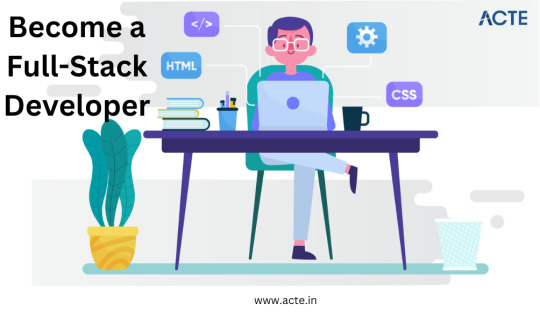
Defining Full Stack Development
At its core, I see a full stack developer as a tech-savvy magician who possesses the unique ability to bring both the user-facing magic of the front end and the powerful machinery of the backend to life. It's not merely about coding; it's about the art of crafting seamless user experiences while skillfully managing the complex infrastructure that makes it all possible.
Self-Assessment
Like any journey, mine began with self-awareness. I took a close look at my existing skills and knowledge. I uncovered my strengths to build upon and identified the areas where I needed improvement. This self-assessment became the bedrock upon which I constructed my roadmap, allowing me to set clear, focused goals for my full stack development journey.
Front-End Development Skills
Mastering front-end technologies proved to be a thrilling challenge. Moving from the foundational HTML and CSS, which provide structure and style to web pages, to delving into the captivating realm of JavaScript with its dynamic interactions, each step forward brought its own set of revelations and challenges. My journey was marked by moments of both frustration and triumph as I evolved from crafting basic layouts to creating intricate user interfaces that sprung to life at the simple click of a button.
Back-End Development Skills
Transitioning to the backend was like stepping into a whole new world of data management, server intricacies, and complex logic. Learning languages like Python, diving deep into databases like MySQL, and exploring frameworks such as Flask and Django became the building blocks of my backend journey. The sheer satisfaction of watching my code efficiently manage data and orchestrate complex operations fueled my determination to keep pushing forward.
Bridging the Gap
The leap from front-end to back-end wasn't a smooth one. Bridging this gap required not only the acquisition of new technical skills but also a shift in mindset. The challenges were numerous – learning to handle data securely, optimizing performance, and orchestrating intricate processes. I adopted various strategies to make this transition seamless, eventually allowing me to unite my front-end and back-end skills into a unified full stack approach.
Full Stack Development Frameworks
The full stack development world introduced me to a plethora of frameworks designed to streamline the entire process. Frameworks like MEAN (MongoDB, Express.js, Angular, Node.js) and MERN (MongoDB, Express.js, React, Node.js) became my trusted companions. They not only accelerated development but also offered valuable insights into the best practices of full stack architecture.
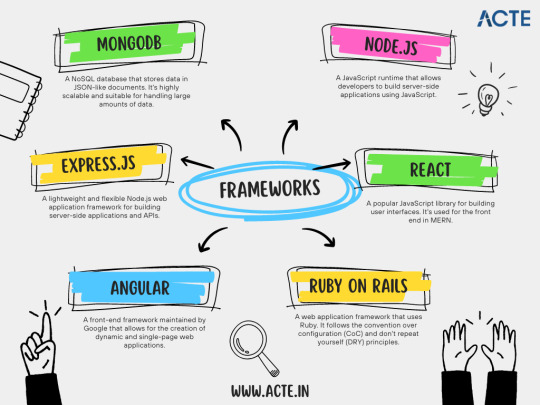
Building Projects
Knowledge truly gains momentum when it's put into practice. Building projects became an essential part of my journey. These projects provided the practical experience necessary to solidify my skills. Whether it was crafting dynamic e-commerce platforms or developing interactive web applications, each project served as a canvas for innovation, experimentation, and continuous improvement.
Continuous Learning
Full stack development is an ongoing journey without a defined finish line. The ever-evolving landscape continually demands learning and adaptation. To stay updated with emerging trends and technologies, I relied on online platforms, coding communities, and valuable resources like full stack developer course and blogs provided by ACTE.
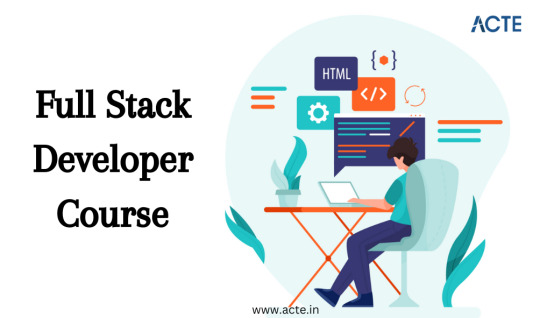
Challenges and Rewards
This journey had its fair share of difficulties, of course. Debugging cryptic errors, optimizing code for performance, and keeping pace with rapid technological advancements were just a few of the hurdles I encountered. However, the rewards far surpassed the struggles. The ability to transform ideas into functional applications, the satisfaction of solving intricate puzzles, and the sheer joy of witnessing my work in action were the driving forces that kept me moving forward.
Networking and Community
In today's digitally connected world, networking is an invaluable asset. Engaging with developer communities and attending meetups opened doors to fresh perspectives, exciting collaborations, and invaluable insights. The support and camaraderie of fellow developers served as a constant reminder that I wasn't alone on this journey.
Becoming a full stack developer is about more than just acquiring technical skills; it's a transformative journey of self-discovery, overcoming challenges, and embracing growth. To all those aspiring full stack developers out there, my advice is to wholeheartedly embrace each challenge as a learning opportunity. Your roadmap may take unexpected turns, but with dedication, resilience, and a deep passion for innovation, you too can navigate the path to mastery. The world of full stack development awaits – so go forth and code boldly!
6 notes
·
View notes
Text
I have been brainstorming soooo much for this #Spidersona thing I have been doing research and working out character arcs and designs and back stories with friends. I really want music to have a major roll in this. I’m thinking I could create a playlist and mess around with those Spotify codes to create a code in the book each person could scan and that song could play as they read through the next couple of panels.
I think I’m mainly posting about this to record it. I’ve never felt this was about a project or idea and I really think I could flush this out into something tangible. I technically have all of the knowledge and skill to work through this and create a physical copy of this graphic novel/idk “interactive” multimedia experience lmao.
Anywho, if anyone happens to see this please drop some songs/playlists for inspiration below. Go obscure, I’m talking like 3 weird recordings on YouTube from a German club obscure, but also I don’t mind the classics (I do plan to have a badass helicopter scene involving all of these mutant freedom fighters to #CCR .)
Here’s some songs I have ideas for rn
THESE ARE THE VIBESSS!
If anyone bothers to read this far hello! Welcome to this virtual project log. I have a tendency to ramble when I’m in a creative mood so after I have that time I like to sit back and reflect on what I’ve learned and write it all down and share it looking for comments questions and ideas. So I hope you like it!
The first video is the amount of pages so far, (the post right before this) I am planning on trying to digitize and rewrite the first “Issue” as a readable post on here so I’m gonna get started on that’s soon. I’m taking a lot of inspirations from Zine culture and alternative comics, body horror ideas from things like the Fly and Johnny the Homocidal maniac, all set to a soundtrack built off of the foundations of rock and the oddity’s of today. The color palate is as if the album cover for the Mountains Goats’ “Goths” came to life, with a formatting similar to one of my favorite books “My favorite thing is monsters” (look it uppppp)
Also, HEY MR. MOUSE! I’m not trying to make money off this, I’m just trying to make some fun art and share it with the world. BUT if you wanna use my characters,hmu (I am delusional) we can work out a deal, have your People call my people.
But that also goes to anyone else out there who wants to work together, my dms are open . . . (Mostly to bots rn)
OH Kay back to it . . . .
In the next pictures are some character designs that are very very very very much inspired by my friends. They’re strange enough that unless you know me by name then you would never get it Lmao . . . But the characters are kinda cool. I really tried to use actual habits and adaptations that these animals have in real life compared to how the human body would have to accommodate for its ability to defy nature. Planning for this to be kinda gory. I’m excited.
Also PSA I know I’m not an amazing artist, I’m going more for story and style over photo realism idk, this is just for my enjoyment, thank you for your time 💖💖💖 to help keep track I’m gonna tag all of these with #OnetaAquatica I’m excited to explore this story and world.
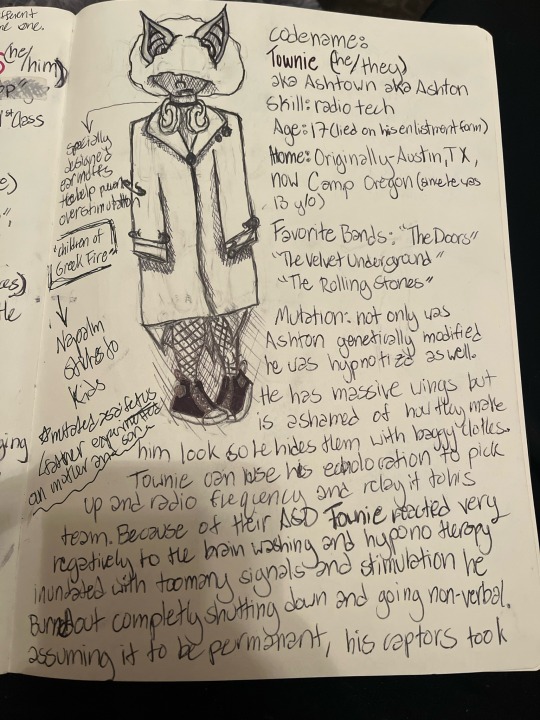
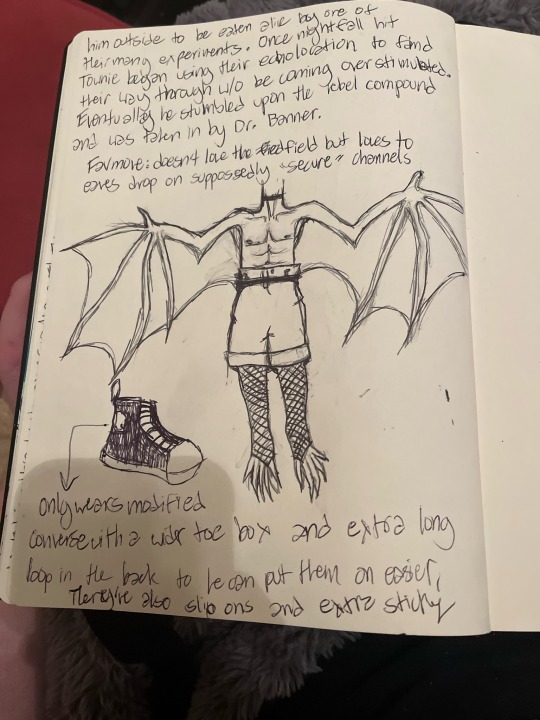
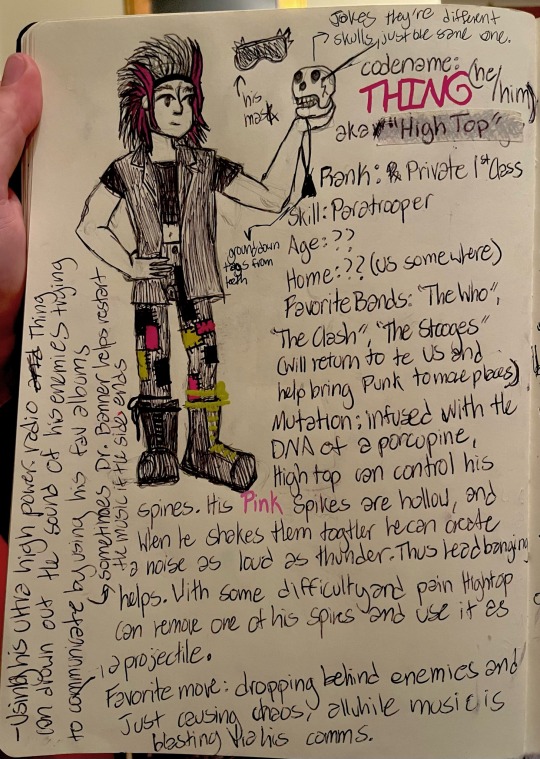
#Spotify#music reccomendations#anti war#historical fiction#fanmade story#Oneta aquatica#spidersona#spider oc#spiderverse
5 notes
·
View notes
Text
BATREIAHT MOTOR SPORTS
Our Existence seems to be dedicated to that of the Bat A species of life found certainly on Planet Thearu questionably upon yes or no but by accurate say sure some planet unless this life is only breeding habitat. The Interesting works of profit and non profit in aiding protection and health of all creature life with Project Earth Water and Air as Fire is well ruled among element unless A volcano the sure Island Corp we create Natural Formation Islands from the power of what man can do with Geologicatural knowledge. Our Mission is to produce motor works the relate characteristically to the of A Bat and That of Bats Bats are flying mammals of the order Chiroptera. With their forelimbs adapted as wings, they are the only mammals capable of true and sustained flight. Bats are more agile in flight than most birds, flying with their very long spread-out digits covered with a thin membrane or patagium. My source is simple as Wikipedia and as to Scientific name: Chiroptera Term for young: pup Wikimedia Foundation Class: Mammalia Domain: Eukaryota Kingdom: Animalia
The World Bank's core mission is to end extreme poverty and boost shared prosperity on a livable planet. This is achieved through a variety of financial and technical assistance provided to developing countries. Specifically, they aim to reduce the percentage of people generating income less then average by 50 to 100% and promote the income growth of the newly founded United Planetary Nation of the United Planetary Nations State of Providence of Planetary Unity of Thearu in every country.
A Institution Company Corporation in all our affairs as A Hawkins Hopkins supporting Corporation A Company A Corporation an Institution Global United Servicing Planetary Entity of the Americas Ameriael Founded Based in Supporting Better Business and A Bettering United Planetary Alliance as we are an honest corporation with interest in global success and international trade and exchange and Foundation base of operations of corporations and institution or moral vale ethics and business affirmative affirmation as our mission and mission and or emissions statements As for some over all a combination of my written mission statement and corporation resources in One A + financial juggernaut pilot astronaut pioneer professional occupational exploration protection and security war and raw business moment maybe inspiration our vision to be on top listed planetary Exilaxy business as we practice and perfection daily production and moral ethics in character occupation. Founder Terry.
Terry Lee Kauffman Hawkins
Terry Lee Hawkins Jr.
traeuthaeou
ALLAHTREU TREUALLAH TRUE SCRAMBLED LANGUAGEOLOGIST
Founder Terry.
Terry Lee Kauffman Hawkins
Terry Lee Hawkins Jr
Blaze
Johns Hopkins Homewood Neighborhood in Baltimore, Maryland The prestigious and sprawling Johns Hopkins University campus in Homewood is home to tree-lined paths, traditional redbrick architecture, and a landmark clock tower. The campus features the Shriver Hall Concert Series and the Baltimore Museum of Art, as well as popular Wyman Park, Wyman Park Dell, and Stony Run Trail. The surrounding area has many taverns and casual eateries popular with students.
Terry Lee Kauffman Hawkins is feeling blessed with Terry Lee Hawkins Jr. 3 mins · Terry Lee Kauffman Hawkins is feeling blessed with Terry Lee Hawkins Jr. 11 mins · Terry Lee Kauffman Hawkins is feeling professional with Terry Lee Hawkins Jr. 1 min · Terry Lee Kauffman Hawkins 4 mins · RAVENDOVE Terry Lee Kauffman Hawkins was RavenDove - yin yin / yang RavenDove - yin yin / yang - COLD NUMB AND (LOVIEY DOVIEY) CALCULATED SPELL IT D or L Dove or Love maybe L or D Lover or Dover pythagorean numerology ABC123 Kauffman-Hawkins-Hawk or Hopk -H__kins aw or op and Hopkins signed Booper or just Boop not Book BUT LOKI OR BOOPER SAN with Blaze Pascal. with Terry Lee Hawkins ( male ) @ikigami shinigam HAWKINS HOKINSU/HOKINZU https://www.facebook.com/notes/terry-lee-kauffman-hawkins/bac-formula-racing-f3-series-bac-mission-statement/2296158727310875/ — feeling professional with Terry Lee Hawkins Jr. YES=Y=YES / NO=N=NO
Blaze
India, officially the Republic of India, is a country in South Asia. It is the seventh-largest country by area; the most populous country from June 2023 onwards; and since its independence in 1947, the world's most populous democracy. Wikipedia
Blaze
Johns Hopkins Homewood
Neighborhood in Baltimore, Maryland
Blaze
traeuthaeou
5m ago
YORK OR WORK HOSPITAL Y LETTER 15 W LETTER 23
The University of Maryland, Baltimore is a public university in Baltimore, Maryland, United States. Founded in 1807, it is the second oldest college in Maryland and comprises some of the oldest professional schools of dentistry, law, medicine, pharmacy, social work and nursing in the United States. Wikipedia
Avg cost after aid
––
Graduation rate
95%
Acceptance rate
––Graduation rate is for non-first-time, full-time undergraduate students who graduated within 6 years. They were the largest group of students (75%) according to the 2022–23 College Scorecard data ·more
From US Dept of Education · Learn more
Address:
620 W Lexington St, Baltimore, MD 21201
Address: 620 W Lexington St, Baltimore, MD 21201
Phone: (410) 706-3100
Blaze
0 notes
Blaze
0 notes
Blaze
0 notes
traeuthaeou
2m ago
ALLAH STEP ONE .. GOD TO ALL THOSE PEOPLE NOT A TWELVE STEP LETTER A TO L PROGRAM AT JOHNS HOPKINS AND GOD OR DOG . CHIP HOUSE HUOJINSEN YOU AN ADULT I AM REPORTING TO YOU. H O U S E - H U O J I N S E N . HAWKINGSON TERRY LEE - SOBRIQUET BOOPER BOOPPER THEOS LOKI TEREMY
Terry Lee Kauffman Hawkins
is with
Terry Lee Hawkins Jr.
May 9 at 4:48 PM
·
Terry Lee Kauffman Hawkins is feeling blessed with Terry Lee Hawkins Jr. 3 mins · Terry Lee Kauffman Hawkins is feeling blessed with Terry Lee Hawkins Jr. 11 mins · Terry Lee Kauffman Hawkins is feeling professional with Terry Lee Hawkins Jr. 1 min · Terry Lee Kauffman Hawkins 4 mins · RAVENDOVE Terry Lee Kauffman Hawkins was RavenDove - yin yin / yang RavenDove - yin yin / yang - COLD NUMB AND (LOVIEY DOVIEY) CALCULATED SPELL IT D or L Dove or Love maybe L or D Lover or Dover pythagorean numerology ABC123 Kauffman-Hawkins-Hawk or Hopk -H__kins aw or op and Hopkins signed Booper or just Boop not Book BUT LOKI OR BOOPER SAN with Blaze Pascal. with Terry Lee Hawkins ( male ) @ikigami shinigam HAWKINS HOKINSU/HOKINZU https://www.facebook.com/notes/terry-lee-kauffman-hawkins/bac-formula-racing-f3-series-bac-mission-statement/2296158727310875/ — feeling professional with Terry Lee Hawkins Jr. YES=Y=YES / NO=N=NO
Blaze
0 notes
Blaze
0 notes
Blaze
0 notes
Enoch Pratt Free Library
4.6301 Google reviews
Public library in Baltimore, Maryland
Website
Directions
Reviews
Save
Share
Call
Description
The Enoch Pratt Free Library is the free public library system of Baltimore, Maryland. Its Central Library is located on 400 Cathedral Street and occupies the northeastern three quarters of a city block ... Wikipedia
Departments: Maryland State Library for the Blind and Print Disabled
Address: 400 Cathedral St, Baltimore, MD 21201
Architect: Edward Lippincott Tilton
Hours:
Open ⋅ Closes 8 PM · More hours
Opened: 1882
Phone: (410) 396-5430
Branches: 22
Director: Chad Helton, President and CEO
Johns Hopkins Homewood
Neighborhood in Baltimore, Maryland
Blaze
0 notes
Blaze
0 notes
Blaze
0 notes
Blaze
0 notes
Blaze
0 notes
Blaze
0 notes
Blaze
0 notes
0 notes
Text
Ahmedabad’s Best Primary Schools: Nurturing Young Minds with Excellence

Education is the foundation of a bright future, and selecting the right school is one of the most important decisions a parent makes for their child. In a city as vibrant and fast-developing as Ahmedabad, parents have access to several schools that promise quality education. But when it comes to finding the best primary school in Ahmedabad, H3 World School stands out as a pioneer in academic excellence, holistic development, and nurturing care.
At H3 World School, we believe that every child is unique and deserves an environment that promotes curiosity, creativity, and confidence. As one of the most trusted CBSE schools in Ahmedabad, our focus is on preparing children not just for exams, but for life.
Why H3 World School is Considered the Best Primary School in Ahmedabad
There are several factors that make a primary school truly exceptional—curriculum, faculty, infrastructure, student-teacher ratio, extracurricular activities, and values. At H3 World School, we bring all of this together in a warm, nurturing environment where children can thrive academically, socially, and emotionally.
1. CBSE Curriculum with a Progressive Approach
As one of the leading CBSE schools in Ahmedabad, H3 World School follows a child-centric curriculum based on the CBSE guidelines. However, we go beyond textbooks by integrating 21st-century skills such as critical thinking, problem-solving, collaboration, and digital literacy into the classroom experience. Our primary classes focus on building strong foundations in language, mathematics, science, and general knowledge, while also encouraging curiosity and inquiry-based learning.
2. English Medium Excellence
If you're looking for the top English medium schools in Ahmedabad, H3 World School is the name to remember. We understand the importance of English in today’s global context, and our teachers are trained to help students master the language while remaining rooted in Indian values and culture. Students become confident communicators, which gives them an edge in every stage of life.
3. Experienced and Passionate Faculty
At the heart of every great school is a team of passionate educators. Our teachers at H3 World School are not only academically qualified but also empathetic and caring. Each child receives personalized attention, and we maintain a healthy teacher-student ratio to ensure no one is left behind.
4. World-Class Infrastructure
Our campus is thoughtfully designed to provide a safe, stimulating, and joyful learning experience. Spacious classrooms, well-equipped science and computer labs, a rich library, digital smart boards, and open green spaces make learning at H3 World School engaging and fun. We also provide transportation facilities across major routes in Ahmedabad for convenience and safety.
5. Holistic Education Beyond Academics
We strongly believe in the holistic development of children. Apart from academics, our students participate in a wide range of co-curricular and extracurricular activities such as:
Music & Dance
Art & Craft
Yoga & Physical Education
Public Speaking & Debating
Environmental Awareness Programs
Cultural Events and Festivals
Through these activities, students develop leadership qualities, emotional intelligence, and a strong moral compass—skills that are essential in today’s world.
What Parents Say About H3 World School
Our parents are our strongest advocates. Here’s what a few of them had to say:
“We visited several schools before deciding on H3 World School. What impressed us most was the balanced approach towards academics and creativity. My daughter loves going to school every day!” — Mr. Rajesh Mehta, Parent of Grade 2 Student
“Teachers here are extremely supportive and approachable. My son has become more confident and expressive since joining H3. Definitely one of the top English medium schools in Ahmedabad!” — Mrs. Nisha Patel, Parent of Grade 1 Student
A Vision for the Future
At H3 World School, our vision is to create a community of lifelong learners who are compassionate, innovative, and globally aware. We believe that education should be a joyful journey, not a race. That’s why we encourage every child to discover their strengths and become the best version of themselves.
As Ahmedabad continues to grow as an educational hub, we are proud to contribute to shaping the future leaders of our society. By focusing on quality, inclusivity, and creativity, we continue to raise the bar for what a best primary school in Ahmedabad should offer.
Conclusion
If you're seeking a school that offers academic excellence, character building, and a joyful learning environment, H3 World School is the right choice. Among the many CBSE schools in Ahmedabad, we are committed to nurturing young minds with care, compassion, and competence.
Whether you’re new to Ahmedabad or a lifelong resident, give your child the gift of a strong educational foundation at one of the top English medium schools in Ahmedabad. Enroll at H3 World School—where young minds are nurtured, and futures are built.
Ready to take the next step? Visit our website or schedule a school tour today to experience the H3 difference firsthand.
0 notes
Text
WebFusion 360: Leading the Charge in Google Business Profile Optimization
In today's digital world, where visibility is key to success, many local business owners find themselves asking a troubling question: "Why is my business not showing up on Google?" WebFusion 360, a stalwart in the field since 2016, emerges as the beacon for local entrepreneurs seeking to improve local search rankings. Specializing in Google Business Profile optimization, we have dedicated ourselves to solving visibility issues nationwide, from New York to Vancouver and everywhere in between. Our mission is to empower clients with clear, data-driven strategies, ensuring their businesses are not just visible, but thriving in Google local results. WebFusion 360's approach doesn't just cut through the digital fog - it obliterates it, offering solutions like Google Maps visibility fix and business listing recovery. Guided by our core values and proven methodologies, we stand ready to turn challenges into opportunities.
Innovative Strategies for Google Business Profile Optimization
Targeted SEO Audits: Laying the Groundwork
An SEO audit is crucial for understanding why a business is not appearing in Google search or why a business listing disappeared from Google. At WebFusion 360, our customized audits identify issues such as duplicate listings and misplaced categories, which can stealthily undermine visibility. By leveraging data-driven insights, businesses can quickly transition from obscurity to prominence.
Technical SEO and its Impact
Technical SEO analysis is another cornerstone of our service, addressing intricate issues that can derail a business's online presence. Through precise adjustments and improvements, we fix Google listing issues, ensuring businesses rank favorably. In this way, we prepare clients for a seamless transition to higher visibility.
Local SEO Strategies: Building Presence
The pivotal role of local business rankings cannot be understated. Our expertise in local search engine optimization services offers a robust pathway to outrank competitors. Successfully placing businesses in the "Top 3 Map Pack" illustrates our proficiency in how to rank in Google local results. Armed with these tools, we bolster clients' readiness for subsequent visibility challenges. By addressing foundational issues and cementing local SEO authority, we set the stage for further advancements in targeted visibility solutions.
Crafting Custom Solutions for Local Visibility
Personalized Optimization Plans
WebFusion 360 rejects one-size-fits-all solutions. Instead, we develop customized strategies using state-of-the-art tools like Cora SEO analysis. Our bespoke plans cater specifically to each business's unique needs, ensuring they get found on Google. This meticulous attention to detail paves the way for enhanced visibility.
Comprehensive Reputation Management
Reputation is paramount in the digital age. With our services, including social media content strategy and online review generation, we safeguard and enhance a business's public image. This proactive approach addresses visibility concerns preemptively, facilitating an organic lift in Google search results.
The Value of Strategic Advertising
Paid advertising campaigns can be the linchpin of a successful visibility strategy. Our bespoke PPC strategies have consistently delivered conversions and visibility boosts, proving especially effective for local businesses not showing up online. These efforts prepare our clients for an upward trajectory in competitive markets. With tailored solutions, reputation reinforcement, and strategic advertising, we equip businesses with tools necessary for sustainable growth.
Empowering Businesses Through Education and Insights
Educating Clients for Sustainable Success
Knowledge is power, and WebFusion 360 commits to educating clients about optimizi
0 notes
Text
Traditional Arts: Getting into Multimedia Arts + Common Questions Answered
Trad Art
Everything is digital nowadays, and you might be wondering, “Do I still need to learn basic traditional skills for multimedia arts?” In my opinion, yes. While it’s totally up to you whether or not you want to learn the basics, having knowledge and skills in traditional art can definitely give you an advantage.
What is Traditional Art?
Traditional art is anything created by hand using traditional materials, like paint, charcoal, clay, canvas, and more. Basically uses any physical and non digital material to produce an art. This type of art has existed for centuries and until today.
Different Types of Traditional ArtThere’s a ton of different types of traditional art out there! Here are a few examples that you may have heard before.
Painting: oil paints, watercolor, acrylics—anything you can paint on a canvas or paper.
Sculpture: Creating 3D artwork out of materials like clay, stone, wood, or metal.
Drawing: Using pencils, charcoal, ink, or pastels to create images
Printmaking: This involves creating multiple copies of an artwork, usually by carving designs into surfaces like wood and then printing them.
Textile Arts: This includes weaving, embroidery, and quilting.
Each of these has its own unique techniques and materials that make them special!
Traditional Art vs. Digital Art
The main difference between traditional and digital art is the medium. Traditional art is made with physical tools and materials, while digital art is created using software on a computer or tablet. Traditional art is more hands-on, painting a canvas, sculpting with clay, and sketching on a paper. Digital art, on the other hand, involves using digital tools like Photoshop, Illustrator, or 3D modeling software.
I personally had a hard time figuring out which medium was best for me. Digital or Traditional?? Both require similar techniques, and you need to have the skills to master either one. Like most artists, I started with traditional art. I mostly sketched on paper using graphite, but soon, I began exploring paints and colors. I really enjoyed it, but the main challenge was that the materials can be quite expensive, especially if you want high-quality materials. On the other hand, digital art drew me in with its convenience. I can take my iPad anywhere and create almost the same thing I would with pencil and paint on a canvas.
Both require tons of patience and practice. Who knows? You might master them both in no time! They’re both great outlets for expressing your art, it just comes down to your personal preference.
What is the Role of Traditional Art in Multimedia Arts?
Now, going back to our first question: is traditional art important in multimedia arts? Absolutely. Traditional art serves as the foundation of all artistic expression. It helps you understand the core techniques, like shading, composition, and color theory, which are essential regardless of the medium you prefer. Once you’ve honed these skills, you have the freedom to explore and experiment in the digital world. Digital tools may offer convenience and new possibilities, but the solid foundation of traditional art gives you the confidence and creativity to push boundaries. Whether you're creating digital illustrations or animations, the skills learned through traditional art will always enhance and enrich your overall artistic journey.
0 notes